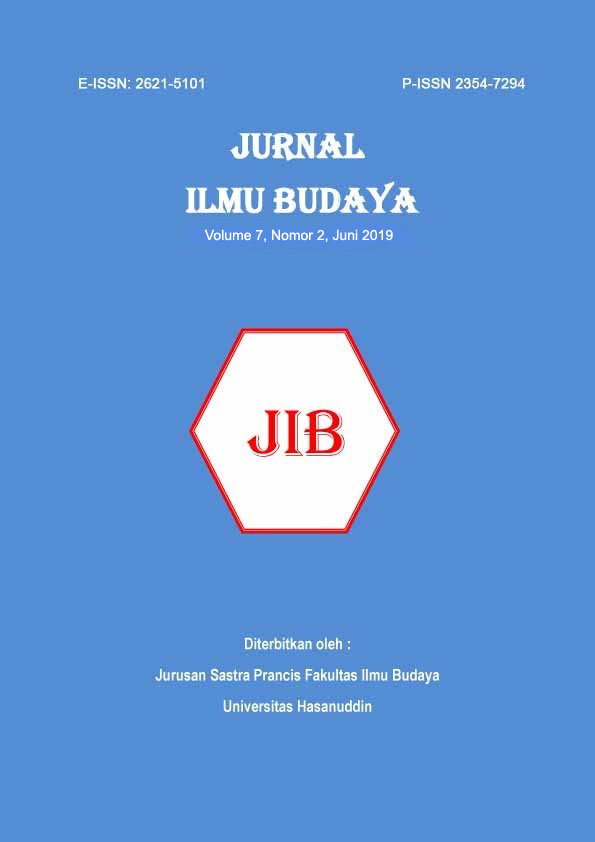BENTUK, MAKNA DAN FUNGSI PEMALI PADA PERILAKU MASYARAKAT PESISIR KABUPATEN MAROS: PENDEKATAN SEMIOTIK
DOI:
https://doi.org/10.34050/jib.v7i1.5722Keywords:
Form, Meaning, Function, Pemali, MarosAbstract
This research aims to describe the forms of pemali as the value of local wisdom in the Maros of District in Bontoa and Maros Baru sub-district, analyze how the meaning of pemali on the behavior of coastal communities in Maros of District, and how the function of the pemali towards local wisdom is in the behavior of the coastal communities of Maros District.The method used in this study is a qualitative method that is describing the form, function and meanings of verbal and non-verbal pemali. Data collection was conducted through surveys and direct interviews with coastal communities in Maros of District. The results of this study indicate that. Verbal form the guards of pemali in coastal communities of Maros District, including: The words Cappu/Tena/De’gaga (completed), Tassala (detached), Pettu (broken off) Cappak (butt end), and Mate (dead) aqgeaq-geaq (be at odds), Abbaju eja je’ne-je’ne ri tamparanga and (bathing on the beach using red clothes) Appoloi bangi, (whistle). And the of non-verbal pemali coastal communities in Maros District, including; Tettong ribawang/Ammenteng ritimungang, (stand at the door) Aqboko (backward). Tinro mopang atau tinro mappang, (sleep face down). Appatinompang (face down the container), Pasampo ulu atau Songko Punggawa, (headgear). Nipiralluangi pa’riolo kanang, (step with your right foot), the meaning of pemali shows religious meaning and social meaning and the function of pemali shows that the function is to protect oneself and as a function of culture.References
Balawa, 2010. Kajian Aspek Didaktis dalam Budaya Masyarakat Berbahasa Ciacia di Kabupaten Buton. Kandai, Kendari: Pusat Bahasa Provinsi Sulawesi Tenggara.
Hasyim, Muhammad. 2017. The Metaphor of Consumerism. Journal of Language Teaching and Research, Vol. 8, No. 3, pp. 523-530
Lodico, G, Marguerite, Dean T. Spaulding, Katherine H. Voegtle. 2006. Methodsin Educational Research From Theory to Practice San Fransisco. Jossey Bass. http://jurnal.methods.ac.id, diakses tanggal 16 Februari 2018, jam 14:00.
Langer, Susanne. (1976). Problem of Arts, edition-6. New York: Charles Sribners Sons.
Mahsun. 2005. Metode Penelitian Bahasa: Tahapan Strategi, Metode, dan Tekniknya. Jakarta: PT Raja Grafindo Persada.
Maknun, Tajuddin, 2012. Nelayan Makassar: Kepercayaan Karakter. (Makassar: Penerbit Identitas Unhas).
Mattalitti, M. Arief. 1998. Pappaseng To Riolota. (Wasiat orang dulu). Jakarta: Depdikbud.
Mattulada. 1985. Latoa (Suatu Lukisan Analisis Antropologi Politik Orang Bugis) Yogyakarta: Gajah Mada University Press.
Milles, M.B. and Huberman, M.A. 1984. Qualitative Data Analysis. London:Sage Publication.
Said, D.M., 1977. Konsep Etos Kerja Menurut Sumber Bahasa, Sastra, dan Budaya Bugis. Makassar. Ujung Pandang IKIP.
Saussure, Ferdinad De. 1993. Pengantar Lingusitik Umum (diterjemahkan oleh Rahayu S. Hidayat). Yogyakarta: Gadjah Mada University Press.
Sobur, Alex. 2006. Semiotika Komunikasi. Bandung: Remaja Rosda Karya.
Sugiono. 2011. Metode Penelitian Kuantitatif, Kualitatif R&D. Bandung, Alfabeta.
Sultan. 2018. Tituran Tolea dalam Ritual Pesta Adat Mosohe Wonua Suku Tolaki Mekonga di Kabupaten Kolaka: Tinjauan Semiotika, Jurnal Ilmu Budaya, Volume 6, Nomor 2, Desember 2018 E-issn: 2621-5101.
Downloads
Published
Issue
Section
License
Copyright (c) 2019 JURNAL ILMU BUDAYA

This work is licensed under a Creative Commons Attribution-NonCommercial 4.0 International License.


